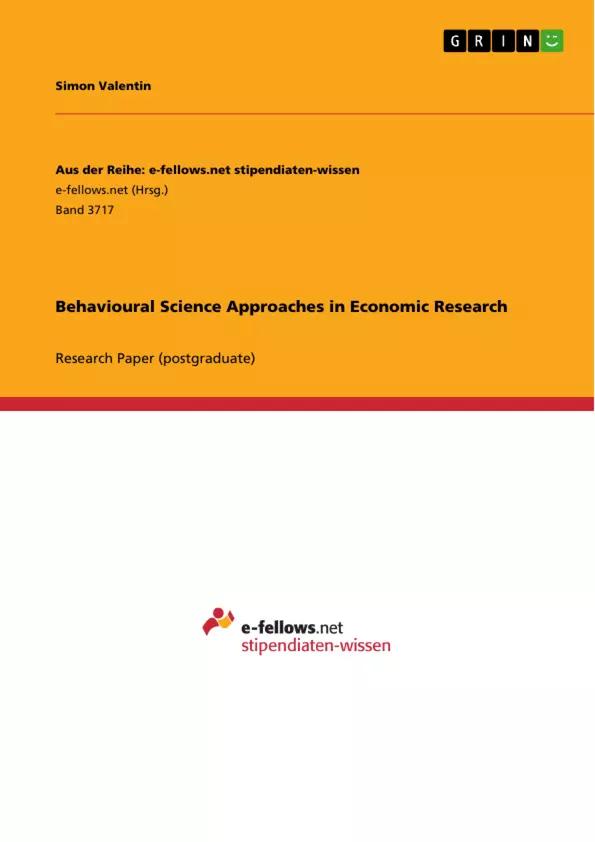This coursework aims to present behavioural science approaches as part of the research programmes course. The coursework places greater emphasis on the research discipline of sustainable marketing and audit. The detailed presentation of the overall behavioural approach with its numerous junctions is presented right after the introduction, which is part of the second section. Sections three and four outlines a brief summary, an analysis of the behavioural scientific approach, the applied research method and findings as well as a critical evaluation of the performed behavioural approach of both the sustainable marketing and audit paper. Section five aggregate the critical appraisal of both behavioural science approaches that are given in section three and four and place them into relationship to the overall behavioural approach. Finally, section six contains the conclusion.
Inhaltsverzeichnis (Table of Contents)
- INTRODUCTION
- THE BEHAVIOURAL APPROACH
- AUDIT PAPER
- SUMMARY
- BEHAVIOURAL SCIENTIFIC APPROACH
- HYPOTHESES DEVELOPMENT, APPLIED RESEARCH METHOD AND FINDINGS
- CRITICAL EVALUATION OF BEHAVIOURAL APPROACH
- SUSTAINABLE MARKETING PAPER
- SUMMARY
- BEHAVIOURAL SCIENTIFIC APPROACH
- APPLIED RESEARCH METHOD AND FINDINGS
- CRITICAL EVALUATION OF BEHAVIOURAL APPROACH
- CRITICAL APPRAISAL OF BEHAVIOURAL APPROACHES
- CONCLUSION
Zielsetzung und Themenschwerpunkte (Objectives and Key Themes)
This coursework aims to present behavioural science approaches as part of the research programmes course. The coursework places greater emphasis on the research discipline of sustainable marketing and audit. The detailed presentation of the overall behavioural approach with its numerous junctions is presented right after the introduction, which is part of the second section. The coursework will explore the applications of behavioural science approaches in the context of business administration, specifically in the fields of audit and sustainable marketing. The work will provide a critical appraisal of the strengths and limitations of these approaches, drawing upon existing research findings and relevant theoretical frameworks.
- The limitations of rational decision-making behaviour in companies.
- The application of behavioural science approaches in marketing and audit.
- The role of motivated reasoning in auditor judgment.
- The impact of promotional cues on consumer behaviour towards organic products.
- The critical appraisal of behavioural approaches in business administration.
Zusammenfassung der Kapitel (Chapter Summaries)
The first chapter provides an introduction to the discipline of business administration, highlighting the need for a clear understanding of its subject matter, methods, and tools. The second chapter delves into the behavioural approach, outlining its fundamental critique of the rational behaviour assumption and its implications for various business disciplines, including marketing and organisation theory.
The third chapter examines a research paper focusing on the influence of client pressure and materiality on auditors' judgments regarding offsetting misstatements. It explores the concept of motivated reasoning and its potential impact on auditor behaviour. The findings indicate that auditors are more likely to adjust misstatements when there is no client pressure and that materiality plays a significant role in auditors' decisions.
The fourth chapter presents a research paper investigating the effectiveness of promotional cues for organic products. The study utilizes a behavioural approach and experimental design to examine the differences in the effectiveness of monetary and non-monetary promotion for different product categories. The findings suggest that non-monetary promotion is more effective for organic products, particularly for hedonic products. The chapter also critically evaluates the limitations of this study.
Schlüsselwörter (Keywords)
The key themes and concepts explored in this coursework include: behavioural science, decision-making, business administration, audit, sustainable marketing, motivated reasoning, dual-process model, heuristics, organic products, promotion, consumer behaviour, critical appraisal.
- Arbeit zitieren
- Simon Valentin (Autor:in), 2021, Behavioural Science Approaches in Economic Research, München, GRIN Verlag, https://www.grin.com/document/986069



